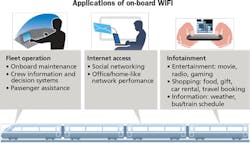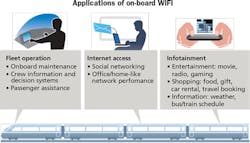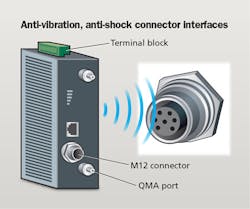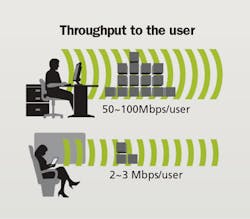Five key considerations for implementing railway passenger WiFi networks
By Zed Shen, Moxa
In recent years, the use of mobile devices for information and communication has changed passengers’ expectations about railway travel. As well as expecting a comfortable journey, passengers are increasingly demanding Internet access and the ability to work on board, to make efficient use of their travel time.
According to a railway industry survey, 65 percent of the respondents plan to provide WiFi connectivity to passengers by the end of 2016 and 60 percent expect to provide content over WiFi within five years.
Beyond simple Internet access, railway operators have also begun to recognize that they can leverage on-board WiFi networks to support a variety of operational and passenger infotainment applications. A digitally connected fleet enables real-time system status reporting and better information flow. These services make operations more efficient, reducing costs, improving service quality, and raising customer satisfaction.
Connecting hundreds of passengers to the Internet at the same time is a daunting task, far harder than operating a simple home or office WiFi network. This article discusses the challenges of on-board WiFi networks and the top five considerations for selecting products to serve a high-density WiFi environment.
Challenges of a high-density on-board WiFi network
The huge growth in use of smartphones and WiFi-enabled mobile devices is the catalyst for the increased usage and ubiquity of WiFi connectivity in public places. In response to the explosive growth in data volume, service providers are offloading traffic from their cellular networks to WiFi networks. Additionally, the changes in user behavior and data network landscape have created a huge challenge for railway operators: to provide enough bandwidth for each passenger in a high-density environment. A traditional enterprise WiFi deployment-just aiming to provide coverage-is no longer enough. In a high-density WiFi infrastructure, operators must look for a solution that combines coverage, bandwidth capacity, and reliability. These characteristics ensure a seamless user experience.
Here are the top five factors to consider when choosing a WiFi solution for high-density deployment in industrial applications-beyond supporting the same standard features as general-purpose access points.
Reliability. An access point (AP) plays a central role in connecting passengers to the on-board WiFi network. However, although many enterprise solutions are available, few meet the requirements of rolling stock operations. Access points suitable for use on trains must include the following characteristics.
- Wide operating temperature - On-board APs could be exposed to extreme hot or cold. The EN50155 standard specifies the operating temperature criteria for different classes of devices. The EN50155 Tx Class defines the widest operating temperature range of -40 to +70 degrees Celsius. To ensure on-board network reliability, APs should be tested to conform to the classification level required for rolling stock applications.
- Anti-vibration/Anti-shock connector design - In an on-board WiFi network, APs usually need to be physically connected to various devices. Many of these devices use a variety of interfaces, such as serial ports, LAN ports, and digital input/output channels. However, shock and vibration are a fact of life in moving trains. APs with an M12 connector for digital communication and QMA antenna ports will ensure reliable cable connections, able to withstand the tough conditions.
- Versatile power input - Power voltage on trains does not always stay constant. There can be sudden changes in voltage simply from the starting or stopping of the train. These voltage dips and surges can damage electronic components and render an AP inoperable. To ensure reliable network connectivity on trains, choose a WiFi solution with at least a 30-percent voltage tolerance range.
High Throughput. It is difficult to predict how much bandwidth each passenger needs to enjoy seamless network connectivity while traveling. Estimates are usually based on studies of application usage and user behavior. In an average home or office, 50 or 100 Mbits/sec is adequate to enable Internet access for multiple devices simultaneously. However, with passengers having more than one device, and considering other factors constraining AP throughput, a recent study concludes that passengers are often left with 2 to 3 Mbits/sec of bandwidth for applications.
In addition, the type of WiFi technologies (a/b/g/n/ac) and applications used can affect the total network capacity. For example, an AP operating in 802.11n mode supports varying speeds but throughput degradation is unavoidable if the network is to support devices in legacy modes.
By taking into account the multiple factors, such as the complexities of the technologies and user behavior, railway operators can design a WiFi network with high throughput to ensure a positive user experience.
High Density Connectivity. If a conventional wireless network is deployed in a high-density user environment, it is not hard to predict the result: poor user experience. This is especially true at live events and on trains where hundreds of users are trying to access the WiFi network at the same time. To provide a good user experience, one study recommends deploying one AP for every 60 users. For example, a train carriage that carries 100 passengers will require at least two APs, each serving 50 passengers. If not enough APs are deployed, some passengers may experience poor connection quality.
Bandwidth-intensive applications such as YouTube reduce the number of users an AP can service. Therefore, in addition to a good AP/user ratio, knowing which applications need to be supported and their bandwidth requirements allows better AP placement and improves bandwidth utilization. Table 2 shows bandwidth required by common applications.
While challenging, finding out how application bandwidth requirements affect capacity is an important step toward designing a high-performance, high-density WiFi network.
Client Load Balancing. When too many client devices try to connect to an AP, the bandwidth available for each client device decreases, eventually resulting in poor connectivity and user experience. With client load balancing, railway operators can limit the number of client devices that can connect to an AP. When this limit is reached, the AP can refuse any new connection requests, forcing client devices to connect to other APs, thereby sharing the available radio channels evenly among client devices in the area. Additionally, client load balancing allows APs to prevent client devices from connecting to a congested channel, encouraging an even distribution of available bandwidth for all client devices.
Although APs cannot force client devices to connect to a specific channel under the IEEE 802.11 specification used by WiFi, there are mechanisms to ensure uniform client associations on all channels on the WiFi network.
Because a client device always connects to the AP with the strongest channel, an inconsistent load condition can still occur in a high-density environment with uniform client distribution. For example, if a large number of client devices happened to be active in a single train carriage, they could connect to only one AP, causing slow connections or even no connection for some passengers and leaving other APs with light loads.
To provide maximum bandwidth for all client devices and enable the even distribution of client devices in a high-density environment, an AP should support effective automatic client load balancing that takes into account the following factors: optimum number of client devices on a channel; signal strength; and favoring 5-GHz channels over 2.4-GHz channels.
Wireless Client Isolation. Railway operators must implement client isolation in a public WiFi network to prevent client devices from communicating with one another; they can only access the Internet. This serves two purposes; it increases network security and limits broadcast traffic.
Every device that connects to on-board APs belongs to the same network, including on-board systems such as broadcast or other control systems. However, unlike a home network where one can freely access resources on different devices, passengers and train operators do not need to access each other’s devices. In fact, they do not want to share resources or information with others, especially with any hackers lurking on a public wireless network.
Wireless client isolation prevents wireless clients from directly communicating with other wireless devices on the same network. This provides an added layer of protection against passengers gaining access to other devices for malicious purposes.
Although broadcast traffic is essential in network discovery and content delivery, it is mostly redundant on a public WiFi network. By using client isolation to limit broadcast traffic between wireless devices, passengers can use the bandwidth that would otherwise be used for broadcast traffic, enhancing overall network performance.
The rise of smartphones and other mobile devices has driven the demand for ubiquitous Internet access, including access for train passengers. An intelligent WiFi solution for a high-density environment allows railway operators to provide both cost-effective operational applications and passenger infotainment applications that can generate additional revenue streams.
The design of a high-density WiFi network is a complex process. By considering a number of important factors-network reliability, data rate, mixed mode client ratios, load balancing, and network security-railway operators can choose an effective WiFi solution that meets the requirements of rolling stock applications.
Zed Shen is a product manager with Moxa (www.moxa.com).







